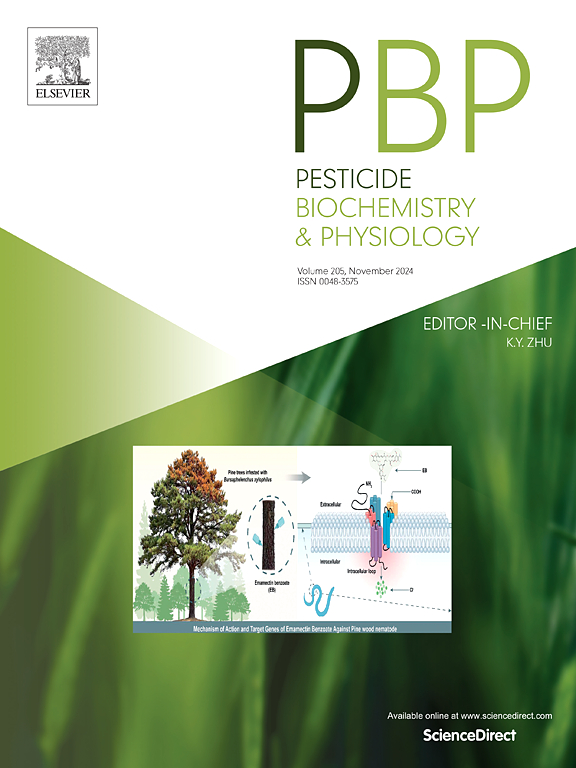A symbiotic bacterium regulates the detoxification metabolism of deltamethrin in Aedes albopictus
IF 4.2
1区 农林科学
Q2 BIOCHEMISTRY & MOLECULAR BIOLOGY
引用次数: 0
Abstract
The mosquito Aedes albopictus is an important vector of dengue, chikungunya, and Zika; and is a globally distributed invasive mosquito with increasing resistance to insecticides, thereby posing a serious risk to global public health. Symbiotic gut bacteria have been shown to be related to insecticide resistance, but knowledge is still limited for A. albopictus. Here, we explored the role of Serratia marcescens, a gut symbiotic bacterium, in the resistance of A. albopictus to the insecticide deltamethrin. Using 16S-rRNA sequencing we found that S. marcescens was significantly enriched in A. albopictus after deltamethrin exposure, and that resistance increased after S. marcescens enrichment. The enzymatic activities of mixed-function oxidase (MFO) and glutathione S-transferase (GST), two important detoxification enzymes, were higher in the bacteria-enriched mosquitoes. The expressions of ABCG4 and GSTD1, two genes related to detoxification metabolism, were up-regulated following S. marcescens infection and after deltamethrin exposure, as assayed using RNA-seq. The up-regulation of these two genes was most significant in midgut and Malpighian tubules. Our results suggest that S. marcescens infection could enhance deltamethrin resistance in A. albopictus by increasing detoxification metabolism; of interest for designing more efficient mosquito control measures.
一种共生细菌调节白纹伊蚊体内溴氰菊酯的解毒代谢
白纹伊蚊是登革热、基孔肯雅热和寨卡病毒的重要媒介;它是一种分布在全球的入侵性蚊子,对杀虫剂的耐药性日益增强,从而对全球公共卫生构成严重威胁。共生肠道细菌已被证明与杀虫剂抗性有关,但对白纹伊蚊的了解仍然有限。本研究探讨了粘质沙雷氏菌(Serratia marcescens)在白纹伊蚊对杀虫剂溴氰菊酯抗性中的作用。利用16S-rRNA测序发现,溴氰菊酯暴露后,粘质雌蚊在白纹伊蚊体内显著富集,且富集后抗性增强。混合功能氧化酶(MFO)和谷胱甘肽s -转移酶(GST)活性在细菌富集的蚊子中较高。RNA-seq检测结果显示,与脱毒代谢相关的ABCG4和GSTD1基因在粘质葡萄球菌感染和溴氰菊酯暴露后表达上调。这两个基因的上调在中肠和马尔比氏小管中最为显著。结果表明,粘质葡萄球菌感染可通过增加脱毒代谢增强白纹伊蚊对溴氰菊酯的抗性;对设计更有效的蚊虫控制措施有重要意义。
本文章由计算机程序翻译,如有差异,请以英文原文为准。
求助全文
约1分钟内获得全文
求助全文
来源期刊
CiteScore
7.00
自引率
8.50%
发文量
238
审稿时长
4.2 months
期刊介绍:
Pesticide Biochemistry and Physiology publishes original scientific articles pertaining to the mode of action of plant protection agents such as insecticides, fungicides, herbicides, and similar compounds, including nonlethal pest control agents, biosynthesis of pheromones, hormones, and plant resistance agents. Manuscripts may include a biochemical, physiological, or molecular study for an understanding of comparative toxicology or selective toxicity of both target and nontarget organisms. Particular interest will be given to studies on the molecular biology of pest control, toxicology, and pesticide resistance.
Research Areas Emphasized Include the Biochemistry and Physiology of:
• Comparative toxicity
• Mode of action
• Pathophysiology
• Plant growth regulators
• Resistance
• Other effects of pesticides on both parasites and hosts.

 求助内容:
求助内容: 应助结果提醒方式:
应助结果提醒方式:


